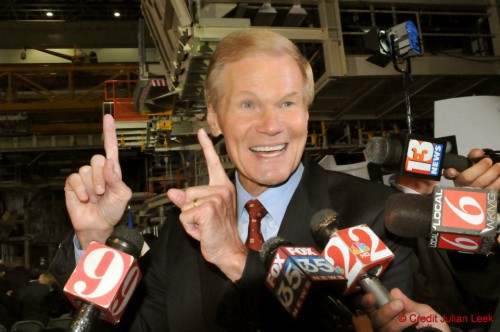
KENNEDY SPACE CENTER, Fla — AmericaSpace has learned that Boeing has yet to sign a lease for Kennedy Space Center shuttle-era facilities for servicing its CST–100 crewed spacecraft. It is unclear, and AmericaSpace has been unable to confirm with Boeing, when it will sign its lease with Space Florida.
On October, 31 2011, under much fanfare, it was announced that the Orbiter Processing Facility 3 (OPF-3) at NASA’s Kennedy Space Center (KSC) in Florida would be leased to Boeing under an agreement through Space Florida and NASA. The structure would then be used to produce the company’s CST-100 spacecraft at the iconic shuttle hangar. A year and a half later and the lease for this structure still has not been signed.
During the 2011 event, the effort to place the OPFs (there are three at KSC) in private hands was described as a sign of things to come—the event being attended by Senator Bill Nelson (D-FL), NASA Associate Administrator Lori Garver, NASA’s Kennedy Space Center Director Bob Cabana, and others. They lauded this agreement as a herald of things to come, with Garver stating, “ … I love what you have done with the place!”

Sources have told AmericaSpace that Boeing has expressed concerns about the viability of the commercial space market after NASA’s investment in the commercial crew concludes. Moreover, there are questions about how long NASA will even pay for crew services to and from the International Space Station (ISS), as the future, and funding, of the ISS beyond 2020 has not yet been determined. If ISS is decommissioned in the early 2020s, and with current commercial crew funding, it is unlikely that the first U.S. commercial crew flight will occur before 2018—that would leave only 2–3 years of crew transfer services and little time to recoup company investments in spacecraft. Some fear that this could be a repeat of the financial disaster that was the EELV program for both Boeing and Lockheed Martin.
Currently, under the Commercial Crew integrated Capability (CCiCap) agreement, the third round of NASA’s commercial crewed efforts is set to conclude in 2014, after which the next round of commercial crew development efforts will begin. As it currently stands, the first commercial flights are not scheduled to occur until November 2017 at the earliest. And according to NASA Administrator Bolden, unless Congress approves the president’s FY2014 $821 million request for commercial crew—which is highly unlikely given the funding history of commercial crew—“ … [commercial crew] could take longer.” Until that time, NASA is dependent on the Russian Soyuz spacecraft for access to the space station.
OPF-3, once home to Space Shuttle Discovery, has now been renamed Commercial Crew & Cargo Processing Facility (C3PF). Boeing’s lease was reported by Space.com as lasting for 15 years.
“Currently Space Florida has an NDA (non-disclosure agreement) with Boeing,” said Space Florida spokesperson Tina Lange during a recent interview. “We are preparing the C3PF for commercial customers that may have an interest in utilizing this legacy infrastructure. To date, the work has been primarily demolition, which prepares the site for any number of possibilities, not solely those presented by the CST-100 program.”
Space Florida meanwhile has continued its efforts of preparing C3PF for potential commercial customers that may materialize.
Phase 1 was started in August of last year, with work on the OPF-3 done by BRPH and Hensel Phelps Construction Company under a $4.5 million contract with Space Florida. They worked to modernize the 30-year-old buildings. Much of the internal structures that were used during the shuttle program were demolished and removed. Under this effort, OPF-3 was converted into what is being called the “clean-room” layout. It is hoped this new design will provide greater flexibility.

“Through the investment the State of Florida is making in this and other facilities, and by marketing them for commercial use, we are sending a strong message to industry that Florida is serious about attracting and retaining a robust commercial space industry,” said Space Florida President Frank DiBello. “This project is an excellent example of our unique ability to re-purpose underutilized federal facilities, and give them a new life for commercial operations.”
NASA has been working for some time to empower several firms to provide access to low-Earth orbit—predominantly, the ISS. Other destinations have also been mentioned, but not detailed. It is hoped that other customers besides NASA will one day take advantage of the ability of sending crews to low-Earth orbit.
Currently, under the Commercial Crew integrated Capability (CCiCap) agreement, the third round of NASA’s commercial crewed efforts is set to conclude in 2014, when the next round will begin. As it currently stands, the first commercial flights are not scheduled to occur until 2017 at the earliest.
Boeing representatives contacted AmericaSpace and provided us with the following comment regarding the status of the lease agreement between Boeing and Space Florida:
“Boeing expects to finalize the lease agreement for OPF-3 soon. While finalizing the lease is taking longer than we’d anticipated, we have not altered our plans to locate our operations in OPF-3. We continue to work with and assist Space Florida on facility modernization specifications and execution plans for our Boeing operations. We are committed to NASA’s commercial space transportation vision and plan and will continue to design, develop, test and launch our Commercial Space Transportation System.”

Want to keep up-to-date with all things space? Be sure to “Like” AmericaSpace on Facebook and follow us on Twitter:@AmericaSpace




3 Comments
3 Pings & Trackbacks
Pingback:Launch Complex 39A for Lease? « AmericaSpace
Pingback:United States and North American News | David Reneke | Space and Astronomy News
Pingback:Historic Structures at Kennedy Space Center Face Uncertain Future « AmericaSpace